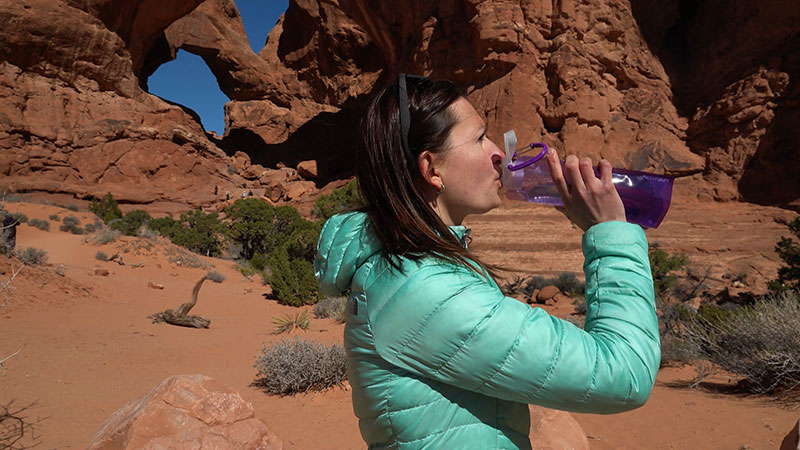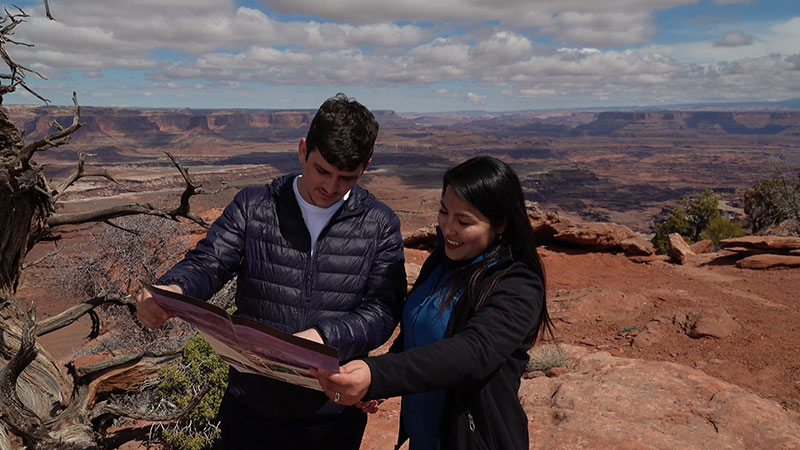Tips from Grand County Search and Rescue
Preparation Is The Key! If you would like to minimize your chances of requiring emergency assistance, here are a few things you can do.
Take clothing layers for extreme temperature changes
Be prepared for temperature extremes. At certain times of the year, it can get cold almost instantly at sunset. Even if you do not plan to be out after dark, take insulating clothing and gear that will help you survive in case you happen to get off the trail or are delayed for any reason. In colder months, take a jacket and/or windbreaker, a hat, gloves, proper footwear, a reflective emergency blanket, etc. Clothing is just as important during the hotter months. A lightweight, long-sleeve shirt and a hat can help you stay cool. Carry sunglasses and sunscreen too.
Take LOTS of water
If you think you have enough water, you probably don’t. Take more. A basic rule of thumb is a gallon per person per day. You may need even more, depending on the time of year. You may only plan to be out for a few hours, but plan on the unplanned. Take extra water. Electrolyte replacement is also essential, so take powdered or liquid electrolytes or something salty.
Take food
Adventure requires energy. Maintain your energy levels with adequate food. Salty foods such as trail mix or energy bars are good choices.
Tell someone where you are going and when you expect to be back
Do not change your itinerary without updating this person. The first place we will look if you are reported overdue is on the trail that you are supposed to be on.
Know your location
Research and study your planned route. Know how to navigate with a good map and compass and/or a GPS. Practice with each. Do not rely on cell phone or tablet navigation apps that require cell service to function. Cell service is notoriously bad in many areas of Grand County. If you do become lost or disoriented, don’t compound the problem by trying to get un-lost. Stay where you are.
Know your skill and fitness level
Check guidebooks for typical riding and hiking times. Then to be safe, double those times. While some experts may be able to do a certain trail in 3 hours, most people might require 6 or 7 hours to do the same trail. Be honest in assessing your skill and fitness levels. Some of Grand County’s trails can be extremely difficult, even for experts.
Take a light
Even if you plan to be back well before dark, take a headlamp or flashlight and extra batteries. Once it gets dark, do not attempt to travel without illumination. The consequences could be deadly.
Take a fire starter
Carry the means to start and sustain an emergency fire. There are many ways to start a fire. Carry a lighter, waterproof matches, or some type of fire starting kit. A knife can aid in carving kindling.
Take a cell phone
Even though cell service is a hit-and-miss proposition in this area, cell phones have helped Grand County Search and Rescue (GCSAR) save numerous lives. Make sure your battery is fully charged and leave the phone off unless absolutely necessary. If you call 911, we should automatically get coordinates for your location if you stay on the phone for about a minute. Sometimes, texting can work in areas where voice service does not. If you are unable to connect via 911, try texting a friend to call 911. Cell phones usually work if you are up on a mesa, but do not work well down in the canyons.
Carry first aid supplies
Accidents happen. Be prepared with at least a basic first aid kit that contains different types of bandages and gauze, adhesive tape, and a method to cleanse a wound.
Know the Weather
Check the forecast before you go out. Pay attention to the weather during the day. In summer months, recreate during the cooler hours earlier or later in the day. Watch for lightning and listen for thunder, especially during Monsoon Season (July through September.) Avoid slot canyons and drainages when thunderstorms are in the area or even miles up the drainage. If you hear thunder, lightning is close enough to strike you. During the winter, avalanche danger in the La Sal Mountains can be extreme. Check the forecast before venturing out: utahavalanchecenter.org/advisory/moab
Wear a Life Jacket
If you are swimming or boating, wear a Personal Flotation Device (PFD). The Colorado and Green Rivers can appear deceptively calm. Visitors have been caught in strong and invisible undercurrents near shorelines and pulled farther out into the river than they originally planned to swim. NEVER try to swim across the river without a PFD. It’s wider than it looks.

Know Local Camping Regulations
Within 20 miles of Moab, camping is only allowed in developed campgrounds. A list of developed campgrounds is available here.
Dispersed (Primitive) camping is available in a few areas outside of Moab. Click here for a map of allowed areas. The following regulations apply to all primitive sites:





